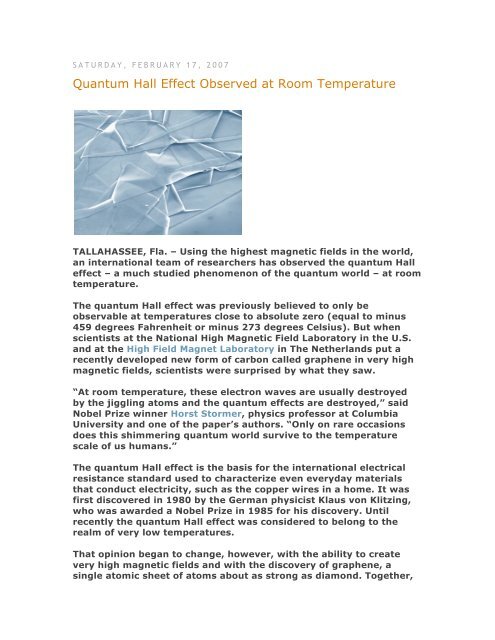Room temperature quantum Hall effect in graphene
Room temperature quantum Hall effect in graphene
Room temperature quantum Hall effect in graphene
You also want an ePaper? Increase the reach of your titles
YUMPU automatically turns print PDFs into web optimized ePapers that Google loves.
S A T U R D A Y , F E B R U A R Y 1 7 , 2 0 0 7<br />
Quantum <strong>Hall</strong> Effect Observed at <strong>Room</strong> Temperature<br />
TALLAHASSEE, Fla. – Us<strong>in</strong>g the highest magnetic fields <strong>in</strong> the world,<br />
an <strong>in</strong>ternational team of researchers has observed the <strong>quantum</strong> <strong>Hall</strong><br />
<strong>effect</strong> – a much studied phenomenon of the <strong>quantum</strong> world – at room<br />
<strong>temperature</strong>.<br />
The <strong>quantum</strong> <strong>Hall</strong> <strong>effect</strong> was previously believed to only be<br />
observable at <strong>temperature</strong>s close to absolute zero (equal to m<strong>in</strong>us<br />
459 degrees Fahrenheit or m<strong>in</strong>us 273 degrees Celsius). But when<br />
scientists at the National High Magnetic Field Laboratory <strong>in</strong> the U.S.<br />
and at the High Field Magnet Laboratory <strong>in</strong> The Netherlands put a<br />
recently developed new form of carbon called <strong>graphene</strong> <strong>in</strong> very high<br />
magnetic fields, scientists were surprised by what they saw.<br />
“At room <strong>temperature</strong>, these electron waves are usually destroyed<br />
by the jiggl<strong>in</strong>g atoms and the <strong>quantum</strong> <strong>effect</strong>s are destroyed,” said<br />
Nobel Prize w<strong>in</strong>ner Horst Stormer, physics professor at Columbia<br />
University and one of the paper’s authors. “Only on rare occasions<br />
does this shimmer<strong>in</strong>g <strong>quantum</strong> world survive to the <strong>temperature</strong><br />
scale of us humans.”<br />
The <strong>quantum</strong> <strong>Hall</strong> <strong>effect</strong> is the basis for the <strong>in</strong>ternational electrical<br />
resistance standard used to characterize even everyday materials<br />
that conduct electricity, such as the copper wires <strong>in</strong> a home. It was<br />
first discovered <strong>in</strong> 1980 by the German physicist Klaus von Klitz<strong>in</strong>g,<br />
who was awarded a Nobel Prize <strong>in</strong> 1985 for his discovery. Until<br />
recently the <strong>quantum</strong> <strong>Hall</strong> <strong>effect</strong> was considered to belong to the<br />
realm of very low <strong>temperature</strong>s.<br />
That op<strong>in</strong>ion began to change, however, with the ability to create<br />
very high magnetic fields and with the discovery of <strong>graphene</strong>, a<br />
s<strong>in</strong>gle atomic sheet of atoms about as strong as diamond. Together,
these two th<strong>in</strong>gs have allowed scientists to push this fragile <strong>quantum</strong><br />
<strong>effect</strong> all the way to room <strong>temperature</strong>. Now there is a way to see<br />
curious and often surpris<strong>in</strong>g <strong>quantum</strong> <strong>effect</strong>s, such as frictionless<br />
current flow and resistances as accurate as a few parts per billion,<br />
even at room <strong>temperature</strong>.<br />
The research was carried out by scientists from the University of<br />
Manchester <strong>in</strong> England, Columbia University <strong>in</strong> New York, the<br />
National High Magnetic Field Laboratory <strong>in</strong> Tallahassee, Florida, the<br />
High Field Magnet Laboratory <strong>in</strong> Nijmegen, Netherlands, and the<br />
Foundation for Fundamental Research on Matter, also <strong>in</strong> The<br />
Netherlands. Their article appears <strong>in</strong> Science Express, the advanced<br />
onl<strong>in</strong>e publication of Science magaz<strong>in</strong>e, a top American journal with<br />
<strong>in</strong>ternational stature.<br />
The scientists believe that these f<strong>in</strong>d<strong>in</strong>gs may one day lead to a<br />
compact resistance standard work<strong>in</strong>g at elevated <strong>temperature</strong>s and<br />
magnetic fields that are easily atta<strong>in</strong>able at the National High<br />
Magnetic Field Laboratory.<br />
“The more we understand the strange world of <strong>quantum</strong> physics, the<br />
better we can design the next generation of ultra-small electrical<br />
devices, which already are push<strong>in</strong>g <strong>in</strong>to the <strong>quantum</strong> regime,” said<br />
Gregory S. Boeb<strong>in</strong>ger, director of the U.S. magnet lab.<br />
“This is a really amaz<strong>in</strong>g discovery for a <strong>quantum</strong> <strong>Hall</strong> physicist,” said<br />
Uli Zeitler, senior scientist at the High Field Magnet Laboratory. “For<br />
more than two decades, we’ve focused our research on explor<strong>in</strong>g<br />
new frontiers such as very low <strong>temperature</strong>s and extremely<br />
sophisticated materials, and now it appears that we can just measure<br />
a <strong>quantum</strong> <strong>Hall</strong> <strong>effect</strong> <strong>in</strong> a pencil-trace and at room <strong>temperature</strong>.”<br />
The room <strong>temperature</strong> <strong>quantum</strong> <strong>Hall</strong> <strong>effect</strong> was discovered<br />
<strong>in</strong>dependently <strong>in</strong> the two high field labs, <strong>in</strong> the 45-tesla Hybrid<br />
magnet <strong>in</strong> Tallahassee and <strong>in</strong> a 33-tesla resistive magnet <strong>in</strong><br />
Nijmegen. Both research groups agreed that a common<br />
announcement on both sides of the Atlantic was the right th<strong>in</strong>g to do.<br />
“Because so many scientists are explor<strong>in</strong>g this excit<strong>in</strong>g new material,<br />
we are all on this roller coaster together,” said Boeb<strong>in</strong>ger.<br />
“Sometimes it makes sense to put competitiveness aside and write a<br />
better paper together.”<br />
In addition to Stormer, Boeb<strong>in</strong>ger and Zeitler, authors on the paper<br />
<strong>in</strong>clude Andre Geim and Kostya Novoselov of the University of<br />
Manchester; Philip Kim, Zhigang Jiang and Y. Zhang at Columbia, and<br />
Jan Kees Maan, director of the High Field Magnet Lab.
This work is supported by the National Science Foundation, the U.S.<br />
Department of Energy, the Microsoft Corp., and the W.M. Keck<br />
Foundation.<br />
For more <strong>in</strong>formation about the experiments, contact<br />
pkim@phys.columbia.edu or geim@man.ac.uk.<br />
field facilities that faculty and visit<strong>in</strong>g scientists and eng<strong>in</strong>eers use<br />
for research. The laboratory is sponsored by the National Science<br />
Foundation and the state of Florida. To learn more, visit<br />
magnet.fsu.edu.<br />
February 15, 2007, Contact: For National High Magnetic Field,<br />
Laboratory:Susan Ray, (850) 644-9651 sray@magnet.fsu.edu, For<br />
High Field Magnet Laboratory: Uli Zeitler, +31 24 36 - 53061 or -<br />
52087 mailto:-52087U.Zeitler@science.ru.nl






